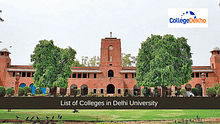Are you a law aspirant who is eager to know which law exam, CLAT or LSAT is tougher and worth appearing for? Get to know more about the CLAT vs LSAT India difficulty level, eligibility requirements, participating institutes, etc.

With the popularity of law courses, more and more students are appearing for law entrance exams every year in order to get admission to their preferred college. So, when it comes to famous entrance examinations, CLAT and LSAT India are among the most popular exams. In many cases, students prefer CLAT or the Common Law Admission Test since that is a gateway for admission to the National Law Universities (NLUs) in India. Law School Admission Test - India is the Indian counterpart of the LSAT (which is administered in the United States) and is primarily administered to some of the country's top private law schools. Now, law students may be wondering which exam to take. Both entrance exams are distinct in their own right, whether in terms of content, exam pattern, or marking scheme. Candidates can clearly differentiate between CLAT and LSAT India. CLAT vs LSAT India article covers all potential aspects of both entrance exams and provides a complete analysis, assisting candidates in building a grasp of both.
CLAT and LSAT are India's two very popular law admission exams through which top law schools admit law aspirants. Every year, thousands of candidates take these entrance exams in the hope of getting into a prominent law school in India. While not all students wish to take both of these legal entrance examinations, they are somewhat confused about which exam will be suitable for them.
This article compares and contrasts the CLAT and LSAT India examinations. Continue reading to see how CLAT and LSAT India differ in terms of institutions accepting exam scores, test pattern, syllabus, difficulty level, eligibility criteria, and more.
CLAT vs LSAT India: Highlights
The Common Law Admission Test (CLAT) is a very popular law entrance exam that is conducted by the Consortium of NLUs to candidates seeking admission to law courses at 22 National Law Universities (NLUs). On the other hand, the Law School Admission Test India (LSAT India) is an entrance exam administered by the Law School Admission Council (LSAC) to candidates seeking admission to various private law schools in India. The below-given highlights between the two exams will provide you with an overview of the important components of both exams.
Criteria | CLAT | LSAT India |
|---|---|---|
Conducting Body | Consortium of NLUs | LSAC |
Exam Level | National | National |
Courses Offered |
|
|
Duration of Courses |
|
|
Participating/ Associated Colleges | 23 NLUs | |
Frequency of Exams | Once a year | Twice a year |
CLAT vs LSAT India: Exam Pattern
The key difference between CLAT UG vs LSAT UG exam pattern is mentioned below:
Criteria | CLAT UG 2024 | LSAT UG 2024 |
|---|---|---|
Exam Mode | Offline/ Pen and paper mode | Online (Remote-Proctored) |
Conducting Body | Consortium of NLUs | LSAC |
Frequency | Once a Year | Twice a year |
Counseling Mode | Online | Offline |
Test Duration | 2 hours | 2 hours 20 minutes |
Type of Questions | Multiple Choice Type Questions (MCQs) | MCQ-based questions |
Total no. questions | 120 | 92 |
Marking Scheme |
|
|
The below-tabulated data shows the difference between CLAT PG 2024 and LSAT PG 2024 exam patterns:
Criteria | CLAT PG 2024 | LSAT PG 2024 |
|---|---|---|
Exam mode | Offline/ Pen and paper mode | Online (Remote-Proctored) |
Conducting Body | Consortium of NLUs | LSAC |
Frequency | Once a year | Twice a year |
Counseling Mode | Online | Offline |
Test duration | 2 hours | 2 hours 20 minutes |
Type of questions | Objective questions based on 300-450 word Reading Comprehension texts. | MCQ-based questions |
Total no. questions | 120 | 92 (approx.) |
Marking Scheme |
|
|
Also Read:Top 20 Law Universities in India Accepting CLAT, LSAT, SLAT Scores
CLAT vs LSAT 2024: Syllabus
The difference between the prescribed syllabus for the CLAT and LSAT examinations (for both the UG & PG courses) is mentioned below:
CLAT UG Syllabus
Following are the important topics from each subject of the CLAT UG syllabus:
Subjects | Topics |
|---|---|
English Language | Synonyms and Antonyms, Tenses, Fill in the Blanks, Active and Passive Voice, Correcting wrong grammar sentences, Rectifying grammatical errors, good understanding of phrases and words |
Current Affairs and General Knowledge | News, non-fiction writing, journalistic papers, international affairs, business magazines, arts and culture, contemporary and historical events, awards and recognitions, significant recent judgments related news, events and personalities |
Quantitative Techniques | Mixtures and alligations, Time and Work, Time, distance, and speed, Fractions and equations, Monetary evaluations, Probability, Permutation and combinations, Number theory and basic arithmetic, Averages and Percentages, Ratio and Proportion |
Legal Reasoning | Legal general knowledge, Indian Polity, Crucial Supreme Court Rulings, Important Acts and Amendments of the Legislature, Current Affairs, and Legal Maxims |
Logical Reasoning | Syllogism, Cause & Effect, Premises & Conclusion, Analogies, Relationships, and Inferences |
LSAT UG Syllabus
Below mentioned are the important topics from LSAT India syllabus:
Subjects | Topics |
|---|---|
Analytical Reasoning | The section is organized around the set of relationships with logical conclusions, people, relationships based on things, or statements, events and conclusions, some legal statements and a few relationship-based problems. |
Logical Reasoning 1 & 2 | Through logical thinking questions based on passages, the sections measure applicants' abilities to analyze, critically evaluate and conclude arguments (comprehension or legal). Statement-conclusion questions, reasoning by analogy, analyzing how more evidence influences an argument, applying principles or rules, and detecting argument faults will be the type of questions. |
Reading Comprehension | The segment contains questions that examine candidates' reading and interpretation skills using four sets of reading questions, each of which includes a selection of reading material followed by four to nine questions that test reading and reasoning ability. |
CLAT PG Syllabus
The subjects under CLAT LL.M include almost all of the law subjects that the law candidates have studied during their undergraduate 3-year or 5-year LL.B degree program. The syllabus of CLAT LL.M is given below in the table that students can look at:
CLAT LLM Syllabus | |
|---|---|
Administrative law | Labour and industrial law |
Law of Torts | Property law |
Family Law | Intellectual Property Law |
Tax law | Environmental law |
Law of Contracts | Company law |
International Law | Jurisprudence |
Constitutional Law | Criminal Law |
Public international law | |
LSAT PG Syllabus
The syllabus for LSAT PG is the same as LSAT UG. The LSAT PG question paper will contain a total of three subjects reading comprehension, analytical reasoning, and logical reasoning - 1 and 2. The sectional time allotted for each subject is 35 minutes, so, the candidates must time themselves efficiently in order to attempt every question. The question paper will be of 2 hours and 20 minutes.
CLAT vs LSAT: Qualitative Comparison
In terms of the types of questions asked and the topics covered, both admission exams are distinct. While CLAT covers a wide range of topics such as general knowledge, mathematics, legal aptitude, and others, LSAT India focuses primarily on assessing applicants' reasoning, reading, and other skills.
CLAT vs LSAT: Eligibility Criteria
Go through the points mentioned below to know the difference between CLAT and LSAT eligibility criteria:
- CLAT UG applicants must have a combined score of 45 per cent (40 per cent for the reserved category) in their 10+2 exams.
- An LLB degree from a BCI-accredited law school is required for the CLAT LLM program. A minimum of 55 per cent (50 per cent for SC/ ST categories) on the graduation degree qualifying exam is necessary.
- For LSAT UG and PG courses eligibility criteria, candidates must have received at least 45 per cent in a Class 12th or equivalent examination from a recognised board or institution. Candidates who take the qualifying exam are also eligible to take the LSAT India 2024 exam. There is no age restriction for taking the LSAT India 2024 exam.
CLAT vs LSAT: Top Participating Colleges
A few of the top institutes that offer admission to undergraduate and postgraduate law students through CLAT and LSAT examinations are mentioned below:
Top Law Colleges Accepting CLAT | Top Law Colleges Accepting LSAT India |
|---|---|
School of Law, University of Petroleum and Energy Studies, Dehradun | |
Which is Tougher CLAT or LSAT India?
CLAT is unquestionably a challenging exam to pass, and it is even regarded as India's toughest legal admission exam. LSAT India, on the other hand, is a little easier, but it is not without risk. LSAT India, Pearson VUE, and LSAT are all well-known around the world for their capacity to qualitatively test students through entrance examinations. Candidates must complete 150 questions in two hours during the CLAT UG exam and 120 questions must be completed by candidates attempting the CLAT PG exam. Furthermore, the questions cover a wide range of themes and subjects, necessitating candidates' knowledge of a broad syllabus. CLAT grading scheme includes a negative marking of 0.25 points for each erroneous answer, which is absent from the LSAT India. Candidates taking the LSAT India must typically solve 92 questions in 2 hours and 20 minutes.
CLAT examination is the way towards being a part of one of the 22 prestigious NLUs in India. Approximately 50,000 students compete for only 2984 slots in the LLB programme, with even fewer seats available in the LLM programme (around 600). As a result, the level of competition is extremely high. On the other hand, LSAT India serves as a doorway to a larger number of law schools, and the level of competition among applicants is lower.
CLAT vs LSAT India: Which one to choose?
Despite the fact that the LSAT India and CLAT are completely different exams, applicants should take both because both exams are for formal law study. The fact that a particular college is linked with the entrance exam or not may also influence a candidate's interest in the legal entrance exam. For example, many individuals desire to get admitted to O. P. Jindal Global University, therefore taking the LSAT India is a possibility they should explore. Similarly, individuals who are more interested in national law schools should take CLAT.
The best recommendation is to take both admission exams and then prepare sensibly by allocating extra time to the selected one. Given the high level of competitiveness in both entrance exams, one should not skip any of them, as the other one ensures that one will have other options.
Also Read: CLAT Cutoff 2021 vs 2020 - Check Category-Wise, Institution-Wise Cut Off Marks & Trend Here
To know more about law admissions in India, stay tuned to CollegeDekho. Send your queries through the Q&A Zone.

















Similar Articles
Tips to Prepare for CLAT 2025 Quantitative Techniques Section
Tips to Prepare for English Language Section of CLAT 2025
How to Score 100+ in CLAT 2025?
CLAT 2025: Exam Date (Out), Registration, Pattern, Syllabus, Admit Card, Result
Colleges Accepting CLAT 2025 Scores & Seat Matrix
Private Law Colleges Accepting CLAT Scores